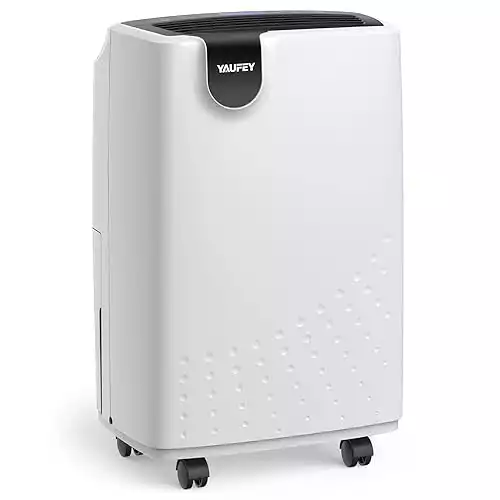In a Nutshell:
The Yaufey 30 Pint Dehumidifier is surprisingly robust and full-featured, this little dehumidifier doesn’t disappoint! Recommended for anyone with a light to medium humidity problem. Perfect for people with smallish to medium-sized indoor growing spaces.
Feature Set
Ease of Use
Value for the Money
Brand Reliability*
Overall Rating
4.3/5
Benefits
Drawbacks
Recommended For: Anyone with a light to medium humidity problem. Perfect for people with smallish to medium-sized indoor growing spaces.
Does your house, boat, or RV have a moisture problem? Do you have a modestly sized indoor growing space and find yourself in need of something to help precisely control the humidity level? If you answered yes to either of those questions, then you’re going to like what you read in this review.
Yaufey isn’t a huge brand, and it’s not especially well known, but they have a reputation for making surprisingly good products, and they take care of their customers. That’s a bit of a pleasant surprise because a great many small to medium-sized brands that import their goods from China to sell in the US tend not to put much emphasis on post-sales service and support. While it would be overselling it to say that Yaufey offers world-class support, they do put some effort into it, and it shows.
We’ll be the first to admit that the Yaufey 30 pint dehumidifier has its share of limitations, and in the sections that follow, we’ll tell you everything the design gets right, and we won’t pull any punches when it comes to describing the unit’s shortcomings. That way, you’ll have all the information you need to decide for yourself if this is the solution to whatever moisture problems you’re having. If that sounds good to you, let’s jump right in and take a closer look!
An Overview of the Yaufey 30 Pint Dehumidifier
Delightfully unobtrusive. That’s the phrase that’s likely to spring into your mind when you see the Yaufey 30 pint dehumidifier for the first time.
It’s certainly not attractive, but neither is it an ugly piece of equipment. It’s well designed with sleek lines and offered in simple white and black, which helps it blend seamlessly into the background where it can do its job in relative quiet. Make no mistake; it’s not whisper-quiet. It does make some noise while it’s sucking the moisture out of the air, but it’s not obnoxiously loud, and after it’s been running for a while, you’ll forget all about it as the hum of its operation fades into the general background noise of your home.
Here are the basic stats that define the model:
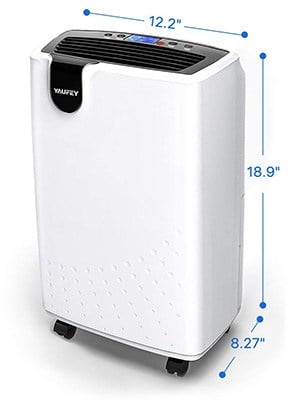
A few things jump out at us about these numbers. First, it’s smaller than you might think, which makes it easy to find a permanent home for the unit. Second, it’s heavier than it looks. Granted, it’s not something you’ll struggle to move around, especially given the casters on the bottom, but it is a bit heavier than it appears, mostly owing to the compressor lurking inside the case.
Third, take a look at the reservoir size versus the extraction capacity. If you put this unit in a high moisture environment to give it a good workout, and you choose not to use the included drainage hose, you’re going to find yourself manually emptying the unit. A lot. You’re going to want to use the drainage hose if at all possible, or you’ll find yourself constantly having to babysit the machine.
That’s not at all uncommon in machines like this, and it’s one of the reasons we tend to prefer dehumidifiers that come with a drainage system. They’re just all-around more convenient.
The power supply is about what we’d expect in a unit of this size and at 260 watts, it’s going to add some heat to your indoor grow room if you’re using it for that purpose, so you’ll want to plan for that, either by bumping up your ventilation or introducing an air conditioner to the space to help keep your growing conditions optimal.
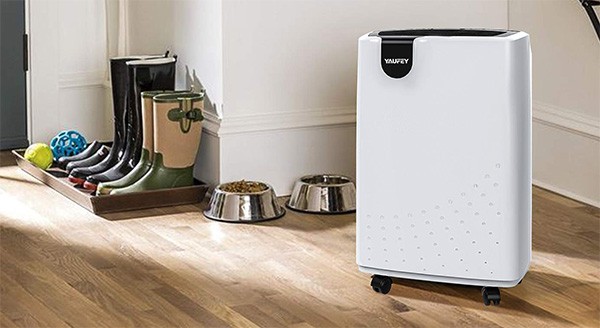
We were a bit disappointed in both the length of the power cord and the length of the drain hose that comes with the unit. The good news is that you can plug the unit into an extension cord and get around the limitations of the stubby power cord, and the odds are good that you’ll want to invest in a longer drainage hose, but that will depend on the particulars of your setup.
Features
There’s actually a lot to talk about in this section of our Yaufey 30 pint dehumidifier review, which is a pleasant surprise, given the relatively modest cost of the unit. Even better, most of the features we’ll be talking about here are surprisingly well implemented, which is another surprise.
So often, what we find in modestly priced equipment that offers a ton of features is that they use something of a scattershot approach, implementing tons of features, some of which wind up being good, and others, not so much. Here, we find that every feature added was implemented with skill, creating a solid product from end to end. Let’s take a closer look.
Water Extraction Capacity
We’ll start with extraction capacity since that’s what really defines the use parameters for the unit. At 30 pints per day, it’s capable of pulling a respectable amount of water from the air. Even better, according to the company’s specs, it’s rated to handle moisture in an area up to 1500 square feet, which makes it a good choice for basements, medium and large-sized rooms, and even smaller to mid-sized homes.
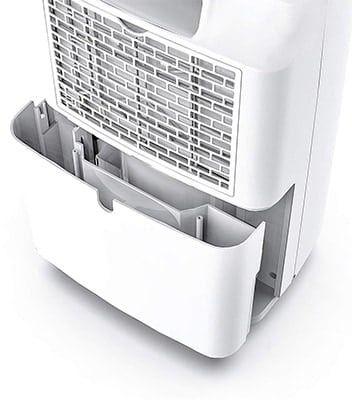
If you have an indoor growing space, the square footage doesn’t matter as much. What you’re really interested in is balancing the critical factors that make up a good growing environment. If you have a large growing space and are feeding your plants a ton of water, this little unit will wind up getting overwhelmed, but it’s perfect for medium-sized grow tents and small to medium-sized grow rooms.
Reservoir
As we mentioned in the last section, this unit has a reservoir that holds about a half-gallon of water, and it comes with a simple gravity-fed drainage system, which basically amounts to a port into which a drain hose is placed, allowing the water to exit the reservoir and go wherever you direct it.
Of all the features on offer, this is probably the weakest of the lot. It’s functional, but there are several things to bear in mind.
First, the drain port is at the top of the reservoir, not near the bottom, so the tank has to fill up before you start to see any drainage. We’d prefer to have seen the port located near the bottom of the drain so it wouldn’t collect much water in the tank if the drainage system was in use. It’s a small thing, but in our view, something that would have made the design stronger.
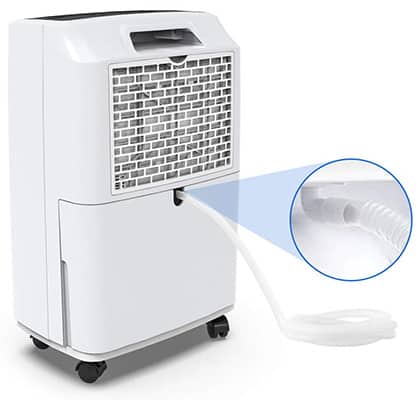
On the other hand, since this unit doesn’t have a pump, it’s easy to understand why the decision was made to locate the drain port near the top of the reservoir. It relies on gravity to move the water out of the tank, after all.
Second, since the system relies on gravity to move water from the tank to wherever you decide to direct it, your best bet will be to place the unit on a platform, so when you place the drainage hose, you can be sure that it’s downhill all the way.
There are a couple of problems here, though. First, the casters don’t lock, so if you set it up on something, you’ll want to brace the wheels with a doorstopper or similar so that if someone bumps or jostles the unit, it won’t roll right off of whatever you’ve got it sitting on.
Second, you’ll probably want the unit somewhat centrally located in whatever room or space you put it in, which is fine, but if you’re a grower, then you’ll want to run the drain hose to a location outside of your growing environment.
That is the idea, after all, to get the excess water out of your growing space, and here, you’ll run afoul of the diminutive little six-foot drainage hose. It’s just not long enough to move the water outside even modestly sized grow spaces if you have it set up somewhere toward the middle of the space, so you’ll want to invest in something longer. Not a huge deal, but it is something to bear in mind.
The other potential problem is this: You can’t set the unit up too high, because the controls and the readout are on the top of the unit, rather than on the side, so you’ll need to be sure you can still read the display, which will limit how high you can place the unit.
None of those issues are insurmountable challenges, of course, but you’ll need to take them into account when figuring out where and how you want to set the unit up.
A final note on this point: Don’t worry too much if the drainage hose gets fouled in some way and stops draining water. The unit has a fill sensor in the reservoir and will automatically shut off if it reaches full capacity. True, while it’s powered off, it won’t be extracting moisture, but it also spares you the frustration of having to clean up a big mess!
Control System
The control system on the unit is surprisingly advanced. It will allow you to set your desired level of humidity and just walk away. If you don’t have a humidistat, you won’t need one. You can just use the readout on the machine.
If you do have a humidistat, be aware that the manufacturer says theirs is accurate to +/-5%, so the readouts may not perfectly agree all the time. Even so, the machine’s read on the relative humidity is close enough for most people’s purposes.
The unit also comes with a timer that allows you to set it to run for a specified period. While that’s cool in theory, in practice, most people are more interested in reaching the desired humidity threshold, and fortunately, the Yaufey allows you to do that too.
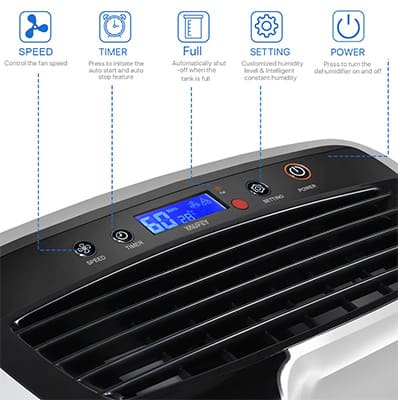
You can specify say, 65% relative humidity and the machine will run until it hits your mark, then automatically power itself off, turning on again if the humidity level creeps above your desired threshold. Very handy and convenient (you can set your desired humidity level between 30% and 80% RH, in 5% increments).
In addition to that, the unit comes equipped with a basic filter and an auto-defrost mode. Neither of these are stellar, but their presence in any form adds to the finish and polish the unit presents. Kudos to Yaufey for that.
Product Warranty
Finally, note that the Yaufey comes with a one-year warranty, and if you register your product within 14 days of receipt, the company will extend that to two years. They also sell a 3- and 4-year extended warranty plan, and given the company’s surprisingly good customer service and support, this is actually a fairly good deal, and unless you consider yourself fairly handy and capable of fixing minor issues that may arise, we provisionally recommend it.
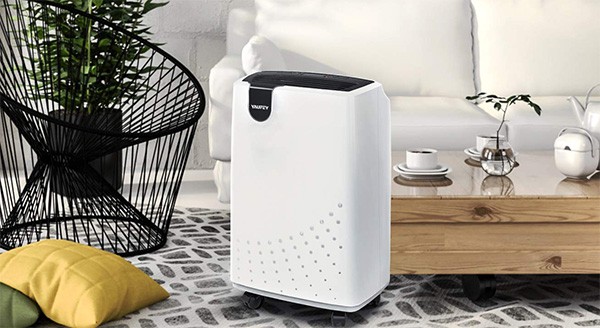
The company also offers free lifetime support, so if you run into a question or problem even after the warranty expires, they’ll be happy to work with you to see it resolved. Again, we can’t stress this enough: Most smaller brands that import their goods from China for resale don’t put much emphasis on customer service. Yaufey is the exception here, and we love them for it!
Pros and Cons of Yaufey 30 Pint Dehumidifier
Here are the things we think you’ll like best about the Yaufey 30 pint dehumidifier:
On the flip side, here are a few things you’ll find annoying or frustrating:
None of the negatives are outright deal-breakers, but to get the most out of this unit, you’ll probably find yourself employing an extension cord and investing in a longer drainage hose.
Yaufey 30 Pint Dehumidifier Review Conclusion
There’s a lot to like about the Yaufey 30 pint dehumidifier. It’s a strong design offered by a company with a good reputation for taking care of its customers. Sure, it’s got its flaws and limitations, but that’s true of everything on the market today.
The big thing to keep in mind when considering whether or not to buy this unit over some other comes down to how much extraction capacity you need. If thirty pints a day gets it done for you, then this is a stellar choice. If that’s a little on the low side for your purposes, you’re better off spending slightly more and getting something with a higher daily extraction capacity.
As long as you don’t ask too much of it, this unit will serve you very well, and we recommend it.
References & Resources
- Yaufey 30 Pint Dehumidifier User Manual.
- Yaufey, Official Brand Website.
- How to Clean You Dehumidifier, Cnet.
- Dehumidifier Hack, Electro Schematics.
- Solution When You Don’t Have a Floor Drain Dehumidifier, Green Home Solutions.
